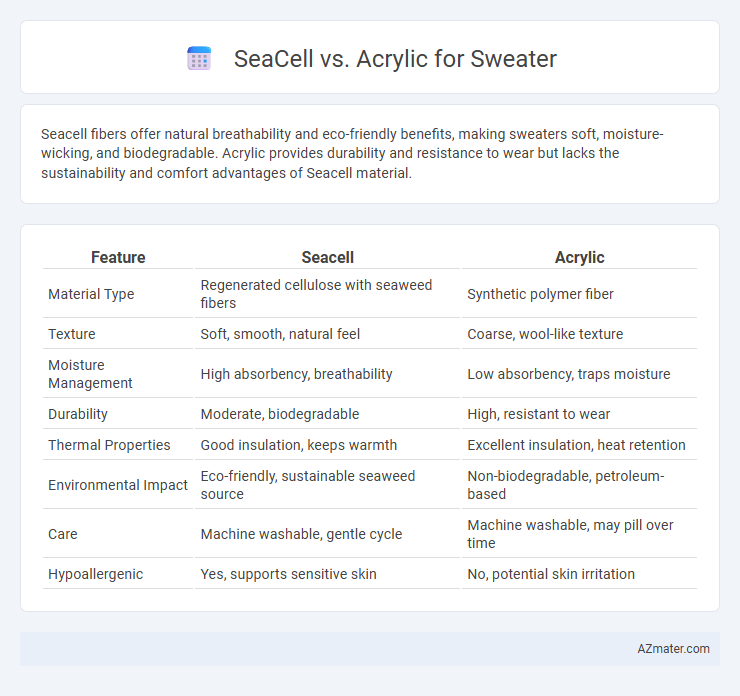Seacell fibers offer natural breathability and eco-friendly benefits, making sweaters soft, moisture-wicking, and biodegradable. Acrylic provides durability and resistance to wear but lacks the sustainability and comfort advantages of Seacell material.
Table of Comparison
| Feature | Seacell | Acrylic |
|---|---|---|
| Material Type | Regenerated cellulose with seaweed fibers | Synthetic polymer fiber |
| Texture | Soft, smooth, natural feel | Coarse, wool-like texture |
| Moisture Management | High absorbency, breathability | Low absorbency, traps moisture |
| Durability | Moderate, biodegradable | High, resistant to wear |
| Thermal Properties | Good insulation, keeps warmth | Excellent insulation, heat retention |
| Environmental Impact | Eco-friendly, sustainable seaweed source | Non-biodegradable, petroleum-based |
| Care | Machine washable, gentle cycle | Machine washable, may pill over time |
| Hypoallergenic | Yes, supports sensitive skin | No, potential skin irritation |
Introduction to Seacell and Acrylic Fibers
Seacell fibers are bio-based textiles derived from seaweed and cellulose, renowned for their eco-friendly properties and skin-soothing benefits, making them ideal for sustainable fashion. Acrylic fibers, synthetic polymers known for their durability, warmth, and resistance to moisture, offer an affordable alternative to natural wool in sweater manufacturing. The choice between Seacell and Acrylic depends on prioritizing environmental impact and skin comfort versus cost efficiency and easy maintenance.
Material Composition and Origin
Seacell sweaters are made from a blend of eco-friendly fibers derived from seaweed and cellulose, combining sustainable marine resources with natural plant-based materials. Acrylic sweaters consist primarily of synthetic polymers produced from petrochemicals, emphasizing durability and affordability but lacking biodegradability. The origin of Seacell fibers traces back to renewable seaweed harvested from clean ocean waters, while acrylic fibers originate from industrial chemical processes involving non-renewable fossil fuels.
Sustainability and Environmental Impact
Seacell sweaters, made from biodegradable seaweed fibers, boast superior sustainability compared to acrylic, which relies on non-renewable petrochemicals and generates microplastic pollution. The production of Seacell fabric involves environmentally friendly processes that reduce water and energy consumption, whereas acrylic manufacturing contributes significantly to greenhouse gas emissions and chemical waste. Choosing Seacell over acrylic supports a circular fashion economy by minimizing ecological footprints and enhancing biodegradability in textile waste management.
Breathability and Moisture Management
Seacell fabric, derived from seaweed fibers, offers superior breathability and moisture-wicking properties compared to acrylic, making it ideal for sweaters in active or warm environments. Acrylic tends to trap heat and moisture, leading to reduced comfort during prolonged wear. The natural moisture management of Seacell helps maintain dryness and freshness, enhancing overall thermal regulation and skin comfort.
Comfort and Skin Sensitivity
Seacell fibers, made from natural cellulose infused with seaweed, offer superior breathability and moisture-wicking properties that enhance comfort and keep the skin dry, making them ideal for sensitive skin. Acrylic, a synthetic material, tends to trap heat and moisture, which can cause irritation or discomfort for individuals with skin sensitivities. Sweaters crafted from Seacell provide a soft, hypoallergenic alternative that reduces the risk of itching and promotes healthier skin compared to acrylic options.
Thermal Properties and Insulation
Seacell fibers offer superior moisture-wicking and temperature regulation, providing natural breathability and moderate insulation while maintaining softness against the skin. Acrylic fibers excel in thermal insulation due to their synthetic structure, trapping heat effectively and making acrylic sweaters warmer in colder conditions. Choosing between Seacell and acrylic depends on the balance of breathability versus maximum heat retention desired in sweater performance.
Durability and Longevity
Seacell fibers, derived from seaweed and cellulose, offer moderate durability with natural antifungal properties that help maintain fabric integrity over time. Acrylic sweaters are known for their high durability, resisting wear, fading, and shrinkage, which contributes to their longer lifespan compared to many natural fiber blends. While Seacell provides eco-friendly benefits and softness, acrylic excels in retaining shape and durability through repeated wear and washing.
Care and Maintenance Requirements
Seacell sweaters require gentle washing in cold water to preserve their natural fibers derived from seaweed, avoiding bleach and tumble drying to maintain softness and longevity. Acrylic sweaters are more durable and can often be machine washed on a gentle cycle, but high heat drying should be avoided to prevent shrinking and fiber damage. Proper care tailored to each material extends the life of the sweater and keeps the fabric looking fresh and vibrant.
Cost Comparison: Seacell vs Acrylic
Seacell sweaters typically cost 20-30% more than acrylic sweaters due to the sustainable and eco-friendly materials used in Seacell fabric production. Acrylic sweaters, made from synthetic fibers, offer a more budget-friendly option with prices often 40-60% lower than Seacell alternatives. The higher price of Seacell reflects its natural seaweed fiber blend, which provides enhanced breathability and skin benefits compared to the cost-effective but less breathable acrylic.
Best Use Cases for Sweater Applications
Seacell fibers enhance sweaters with natural breathability, moisture-wicking, and skin-soothing properties, making them ideal for sensitive skin and eco-conscious consumers seeking sustainable comfort. Acrylic fibers provide lightweight, durable, and warm sweaters that maintain shape and resist wrinkles, perfect for everyday casual wear and budget-friendly options. Choosing Seacell suits sweaters designed for moisture management and softness, while Acrylic excels in vibrant color retention and easy-care fashion sweaters.

Infographic: Seacell vs Acrylic for Sweater
 azmater.com
azmater.com